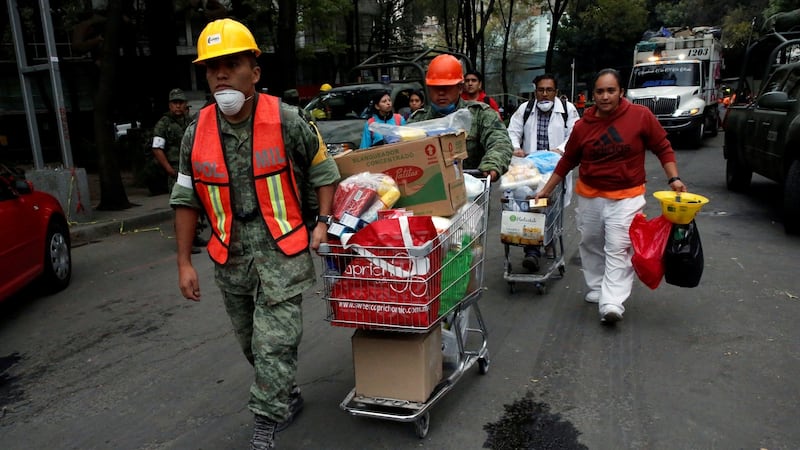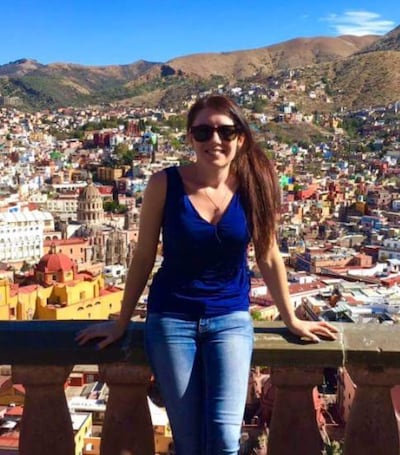One of the most powerful earthquakes in Mexican history has left more than 224 people dead. The magnitude 7.1 quake toppled dozens of buildings, broke gas mains and sparked fires on Tuesday night. As rescue services continue to pull people from the rubble, Irish Times Abroad readers living in Mexico have been sharing their eye-witness accounts and experiences.
[ join the Irish Times Aroad Network hereOpens in new window ]
Dylan Brennan, Santa Fe, Mexico City: ‘We knew that in the city centre, people would die’
September 19th, 2017 was like all the others in Mexico City, for a few hours anyway. We had an earthquake evacuation drill our school, to commemorate the catastrophic quake of 1985, which killed around 10,000 citizens and left the centre of the city in ruins. People my age and older can still remember the rows of corpses in the streets, the stories of mothers and fathers found crouching over their children, the schools that collapsed.
We made our way out of the classroom towards the designated areas and, after a few words on the importance of being prepared, got back to work.
I work at a secondary school in the Santa Fe area of the city, where tremors are rarely felt. Mexico City was constructed on a lake, Santa Fe in the sturdier hills towards the southwest. A few weeks ago, I jested with a colleague that, were we to ever feel a quake up in Santa Fe, we’d gaze down from the hills upon a city in rubble.

The recent 8.1 earthquake occurred in the sea, southwest of Chiapas, many miles from the megalopolis. Still, it was felt. My house is more than 100 years old and shook like a ship in a storm. Lily, my wife, jolted me awake and we ran out into the street where parked cars were rocking back and forth. This was the strongest one we’d ever felt. More than a thousand aftershocks followed, the strongest a 6.1.
Still, little or no damage was done in the city. The affected areas were among the poorest, the southern states of Oaxaca and Chiapas. We donated 10 first-aid kits, and saw many many others lining up near the Zócalo, to do the same. Later I saw a news report about a truck carrying supplies south toppling over somewhere in Oaxaca. People from a local town made off with the supplies. They probably needed help too.
A day or two later, a tiny 2.6 tremor occurred in Tlalpan, in the south of Mexico City. Strangely enough, due to the proximity of its epicentre, it was this tremor that caused some minor structural damage in the city. People wondered what would happen if we got a stronger one close to the city.
And then it happened, on the 32nd anniversary of the devastation of ‘85, a 7.1 quake in the state of Puebla, just a couple of hours outside Mexico City. It happened while I read Macbeth with my students. I was leaning against the classroom wall. The wall moved, as did the floor. We made it to our designated area quickly and efficiently. Some minor damage to staircases, some frightened students, nothing too bad. But we knew. We knew that down in the city centre, down there on the lake bed, people would die.

Reports came in quickly about falling buildings, about a school that had collapsed. Phone lines were down, everyone frantically messaging loved ones. Eventually I got in touch with my wife; she had been at the gym and ran into the street without her phone. A stranger lent her one.
There were gas leaks on our street, a fragile old hotel was crumbling slightly. If it falls forwards onto the street it will crush cars, if it falls backwards, it will crush our building. It’s still standing as of this morning.
I texted a friend to ask if he was okay. He replied: “Yes, barely.” He found himself on the second floor of an eight-storey building, in a waiting room. The building shook and he made his way to the doorway. Then the wall beside him disintegrated. He managed to get to the ground level and crouched down, braced for impact, thinking he might, just might be rescued from the rubble. There was silence from those hit by falling masonry, in front and behind. Hysteria from others.
They barrelled their way out. Maybe 15 people escaped. Once on the street, he did what I would have done. He ran home to his wife, covered in rubble-dust. “There’s blood on your shirt,” she told him. “It’s not mine,” he said.
Traffic is a nightmare in this city on the best of days, and yesterday it was impossible to get through it. I ended up walking miles through the streets. As I approached the centre of town, I was alarmed to see so many people with suitcases, looking for hotels, too nervous to stay in their own buildings.
I ended up doing the same. I am writing this in my friend’s house. We just had breakfast. My wife and the others have gone out to help out with rescue efforts. Last night we donated blood. We have to do something.
There were images on the television of a school in which 20 children have died and some 29 remain missing. We screamed in unison at the screen for the cameraman to get out of the way of the rescue workers.
Luckily that cameraman is in the minority. The people of the city are coming together to help out, to search through rubble, to buy bandages and medicine, pickaxes and torches. I have to stop writing now. There’s too much work to be done.
Dylan Brennan is an Irish poet and teacher based in Mexico City. He tweets @DylanJBrennan

Stephen Murray, Mexico City: ‘The selfless force of community has revealed the best of Mexico’
The earthquake began a few seconds before the earthquake alarm sounded. I was in my house at the time in the most tremor-prone neighbourhood of Mexico City, Roma Norte. The building swayed like someone slowly throttling the neck of another person. I was with a 99-year-old friend who calmly asked with great humour, "We must have drunk a lot of alcohol, this house is moving a lot."
When I went outside on the street the first shock of the terrible power of the moving earth and buildings - you feel so helpless because you are directly connected to the swaying floor or pavement - this was then exaggerated by the desperate calls to loved ones and especially kids in school; without any mobile connection people got even more hysterical and there was a lot of crying.
A little later there was another atmosphere, a giddy excitement to help among the young above all, looking rapidly to find where volunteers are needed. Social media carries exchanges of advice about where the heaviest damage is, what is needed - the torches, batteries, bottles of water, shovels, plastic buckets - and comments about cracks whether they be horizontal, vertical or diagonal that tell you if a wall is about to fall down.
I can only say that fortunately the Mexicans have learnt from the awful earthquake exactly 32 years ago and there has been better construction standards since then, there has almost been a "quality contest" in terms of which buildings have randomly collapsed, the ones with poor supporting walls or internal frames and pillars are those that fell, some others have bits of their facades missing.
The whole selfless force of community has revealed the best of Mexico, and people here are already hoping that this civic sense continues so that people are more on top of delinquency and dishonesty. But extreme times produce string reactions that almost always run out of steam sooner or later.
Gavin Hampton, Monterrey: ‘This terrible tragedy will have lasting effects on the Mexican people’

I am originally from Downpatrick in Co Down, and have been living in Monterrey, where my wife is from, two years ago. We have two children, Liam and Diego. They are enrolled at the Instituto Irlandes here in Monterrey, a school with strong links to Irish missionaries.
I work as a strategy manager for a language services provider called Word Factor based in Mexico City. I work from home and was on a video call with a colleague yesterday when I heard items crashing around him as the earthquake happened. He was quite calm and just said “It's an earthquake, I have to go,” and he ran from the building. It took a while to account for every team member as services such as electricity, phones and water were cut in some areas but thankfully everyone from work is safe and well.
The effects of the 1985 earthquake still resonate with the Mexican people, and the fact that it happened on the anniversary makes it more difficult to take. My brother-in-law lost his father in the '85 quake and he moved to Monterrey with his wife a few years ago to avoid the known risks of earthquakes in Mexico City.
Mexicans are very proud of their country and today they are traumatised by what happened to the people of Morelos and Mexico City. An existing infrastructure is in place for making donations following the Oaxaca earthquake a few weeks ago and it feels like help will get to the affected areas even faster than it might have otherwise. People can donate items in restaurants, schools and supermarkets. Our children's school opened a Moneypool (online account to collect funds) last night which filled within minutes. It feels as though everyone is pulling together to help as much as they can.
For the last few weeks the news has been dominated by scandals and corruption in Mexican politics and it was depressing for people to watch. However, things changed in an instant and the people are pulling together again in a patriotic effort to get the country back on its feet. My work colleagues are on the streets this morning contributing to the relief effort. It is a terrible tragedy that will have lasting effects on the psyche of the Mexican people but in the short term the collective effort to help those affected is impressive to watch.
Ciara Cleary, La Condesa: ‘We got word of buildings collapsed nearby and rushed to help’

I was in my apartment in La Condesa for the first earthquake 10 days ago. It shocked a lot of people, particularly in my neighbourhood where the buildings shook quite violently. Luckily, little damage was done as the epicentre was quite far away.
On Tuesday, for the second one, I was in my office in Santa Fe, where I have been working as a patent agent in biotech for the past two years. Just two hours after the annual earthquake drill, which takes place every year on the anniversary of the 1985 earthquake, I was walking out to eat and all the glass in the building started shaking. People panicked and fled out into the streets. They told us all to make our way home as there was no way anyone could work after that. Due to the insane amount of traffic, lack of Ubers, gas leaks, closed streets and panic, a friend and I ended up walking 10km home in high heels.
After three hours, I got to my building. The road was covered in debris and glass. Cracks were all over the walls inside and the door of my apartment had fallen down. We got word of a few buildings collapsed nearby and rushed to help. The attitude of the locals was truly amazing. Hundreds lined the streets to help clear debris, while others made quesadillas to keep energy levels up, or provided a constant supply of water for the volunteers.
The authorities took hours to arrive to some places; the locals did the majority of the work at the beginning. The entire neighbourhood smelt of gas and we got a few orders to start running in fear of an explosion. When I was there, they managed to pull out four people alive from the debris of one building. Little sleep was had last night.
I woke up this morning to helicopters hovering above and hundreds of messages. I am still a bit on edge as the safety of all buildings has to be checked. But I am proud of the reaction of all the Mexicans and expats here in La Condesa.
John Dunbar: ‘I feel proud to live in a country where people come together and help each other’
I have experienced the greatness of Mexicans in any natural disaster, be it hurricane or earthquake. The initial reaction was shock, confusion and disbelief; it was 23 years ago that a major quake devastated Mexico City and many residents have memories of those days.
But true to their nature it only took a few minutes before people started to react and began to organise, on seeing what had happened hundreds of people started to gather in different parts of the city, using their bare hands and whatever was available to aid and save their fellow citizens. The Army, Navy, Municipal and city authorities along with groups like the Red Cross, Scouts (which I am involved with) and other civil organisations were quick to organise.
I feel very proud to live in a country where people come together and help each other. The stereotype of what Mexicans are meant to be in the minds of so many and which has been in the news lately is completely wrong: They are generous, kind and courageous. And they live up to those qualities, more so in moments like these.
Daragh McMunn, Morelia: ‘The reaction of the ordinary people has been amazing’
I live in Morelia, Michoacan, three hours from Mexico City. Here I work as a 6th-grade teacher and although we felt the tremors and had to evacuate the school, luckily no one was hurt or there was no major damage.
School was cancelled today, as all buildings needed safety checks. In reality what we felt here was nothing. Mexico City, Morelos, and Pubel were the ones who suffered. But what I have noticed was a real sense of unity since it happened. Mexico is often a country of suspicion and fear, due to so much violence, where people often wouldn't trust their neighbours. But from what I have seen and heard, the reaction has been incredible. Thousands of volunteers lining the streets, helping in whatever way they can. Clearing rubble, making food, offering free transport, opening their wifi, setting up makeshift clinics, opening their homes, working day and night, rescuing people and animals; organising food, medicine, and clothes collections. The people are naturally very shocked and down. This is the second earthquake in a month.
But the reaction of the ordinary people has been amazing. It is the side to Mexico that many never see or hear of outside this country. I have lived here for almost six years now and it fills me with pride to see so many people doing whatever they can to help. It is a country full of warm-hearted and loving people and hopefully, it won't be long before it recovers stronger than before.
[ join the Irish Times Aroad Network hereOpens in new window ]

















